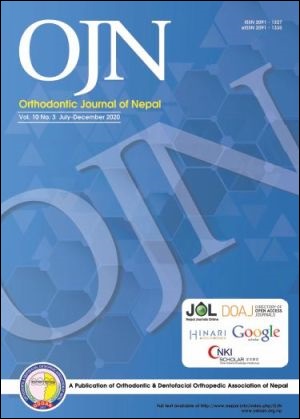Prevalence of malocclusion in Parsa district: A comparative study
DOI:
https://doi.org/10.3126/ojn.v10i3.35484Keywords:
Class I, II, III Malocclusion, PrevalenceAbstract
Introduction: Malocclusion is one of the commonest problem in dentistry and the knowledge on its prevalence on particular population group is very important to plan oral health activities. The objective of this study is to assess the prevalence of malocclusion in school going children of Parsa district, Nepal, and to compare the same with previous study.
Materials and Method: The sample consisted of 250 males and 210 females (total of 460 subjects) aged between 6 to 17 years. Subjects without any previous orthodontic treatment and with no dental anomalies were included in this study. Census sampling was done for the patient visiting orthodontic from November 2018 to March 2019. Classification of malocclusion was based on Angle’s classification of malocclusion. Collected data were entered in Microsoft Excel 2007 and converted into Statistical Package for Social Science (SPSS) Version 11.5 for statistical analysis. For descriptive statistics, percentage and proportion, were calculated, also tabular presentation were performed. For inferential statistics, Chi square test were used for intergroup comparison.
Result: School going children of Parsa district, Nepal suggests 50.47% female and 45.6% of male exhibits Angle’s Class I malocclusion, 29.04% female and 30% male exhibits class II pattern, 11.4% female and 12.0% male exhibits class III pattern. The other findings reported in the study were, the occurrence of crowding of teeth more in males whereas the occurrence of spacing is more in females.
Conclusion: Majority of the subjects in the study had Class I malocclusion. Only 9.04% female and 12.4% of male showed normal class I occlusion. The occurrence of crowding of teeth more in males whereas the occurrence of spacing is more in females. This may be due to the incidence of missing tooth is more in females.
Downloads
Downloads
Published
How to Cite
Issue
Section
License
Copyright © held by Orthodontic & Dentofacial Orthopedic Association of Nepal
- Copyright on any research article is transferred in full to the Orthodontic & Dentofacial Orthopedic Association of Nepal upon publication in the journal. The copyright transfer includes the right to reproduce and distribute the article in any form of reproduction (printing, electronic media or any other form).
- Articles in the Orthodontic Journal of Nepal are Open Access articles published under the Creative Commons CC BY License (https://creativecommons.org/licenses/by/4.0/)
- This license permits use, distribution and reproduction in any medium, provided the original work is properly cited.




